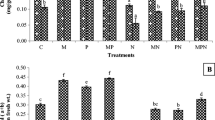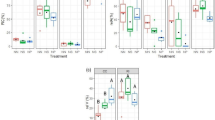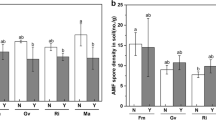Abstract
Arbuscular mycorrhizal (AM) fungi and plant growth-promoting rhizobacteria (PGPR) have potential for the biocontrol of soil-borne diseases. The objectives of this study were to quantify the interactions between AM fungi [Glomus versiforme (Karsten) Berch and Glomus mosseae (Nicol. & Gerd.) Gerdemann & Trappe] and PGPR [Bacillus polymyxa (Prazmowski) Mace and Bacillus sp.] during colonization of roots and rhizosphere of tomato (Lycopersicon esculentum Mill) plants (cultivar Jinguan), and to determine their combined effects on the root-knot nematode, Meloidogyne incognita, and on tomato growth. Three greenhouse experiments were conducted. PGPR increased colonization of roots by AM fungi, and AM fungi increased numbers of PGPR in the rhizosphere. Dual inoculations of AM fungi plus PGPR provided greater control of M. incognita and greater promotion of plant growth than single inoculations, and the best combination was G. mosseae plus Bacillus sp. The results indicate that specific AM fungi and PGPR can stimulate each other and that specific combinations of AM fungi and PGPR can interact to suppress M. incognita and disease development.



Similar content being viewed by others
References
Ahmed SH, Abdelgani ME, Yassin AM (2009) Effects of interaction between vesicular-arbuscular mycorrhizal (VAM) fungi and root-knot nematodes on Dolichos bean (Lablab niger Medik.) plants. AEJSA 3:678–683
Akhtar MS, Siddiqui ZA (2008) Biocontrol of a root-rot disease complex of chickpea by Glomus intraradices, Rhizobium sp. and Pseudomonas striata. Crop Protect 27:410–417
Attia M, Awad NM (2003) Assessment the impact of certain growth promoting rhizobacteria strains on symbiotic effectiveness of arbuscular mycorrhizal fungi. Egypt J Microbiol 38:75–88
Barea JM, Toro M, Orozco MO, Campos E, Azcón R (2002) The application of isotopic 32P and 15N-dilution techniques to evaluate the interactive effect of phosphate-solubilizing rhizobacteria, mycorrhizal fungi and Rhizobium to improve the agronomic efficiency of rock phosphate for legume crops. Nutr Cycl Agroecosyst 63:35–42
Bashan Y, Holguin G (1998) Proposal for the division of plant growth-promoting rhizobacteria into classifications: Biocontrol-PGPB (plant growth-promoting bacteria) and PGPB. Soil Biol Biochem 30:1225–1228
Bashan Y, Holguin G, Lifshitz R (1993) Isolation and characterization of plant growth-promoting rhizobacteria. In: Glick BR, Thompson JE (eds) Methods in plant molecular biology and biotechnology. CRC Press, Boca Raton, pp 331–345
Becker JO, Zavaleta-Mejia E, Colbert SF, Schroth MN, Weinhold AR, Hancock JG, Van Gundy SD (1988) Effects of rhizobacteria on root-knot nematodes and gall formation. Phytopathology 78:1466–1469
Biermann B, Linderman RG (1981) Quantifying vercular-arbuscular mycorrhizas: a proposed method towards standardization. New Phytol 87:63–67
Biró B, Koves-Pechy K, Vörös I, Takács T, Eggenberger P, Strasser RJ (2000) Interrelations between azospirillum and rhizobium nitrogen-fixers and arbuscular mycorrhizal fungi in the rhizosphere of alfalfa in sterile, AMF-free or normal soil conditions. Appl Soil Ecol 15:159–168
Byrd DW, Kirkpatrick JT, Barker KR (1983) An improved technique for clearing and staining plant tissues for detection of nematodes. J Nematol 15:142–143
Caroli L, Glazer I, Gaugler R (1996) Entomopathogenic nematode infectivity assay: comparison of penetration rate into different hosts. Biocontrol Sci Technol 6:227–233
Cooper KM, Grandisons GS (1986) Interaction of vesicular-arbuscular mycorrhizal fungi and root-knot nematode on cultivars of tomato and white clover susceptible to Meloidogyne hapla. Annu Appl Biol 108:555–565
Dai M, Wang HX, Yin YY, Wu X, Liu RJ (2008) Effects and mechanisms of interactions between arbuscular mycorrrhizal fungi and plant growth promoting rhizobacteria. Acta Ecologica Sinica 28:2854–2860 (In Chinese with English abstract)
de la Peña E, Echeverría SR, van der Putten WH, Moens FHM (2006) Mechanism of control of root-feeding nematodes by mycorrhizal fungi in the dune grass Ammophila arenaria. New Phytol 169:829–840
dos Anjos ECT, Cavalcante UMT, Gonçalves DMC, Pedrosa EMR, dos Santos VF, Maia LC (2010) Interactions between an arbuscular mycorrhizal fungus (Scutellospora heterogama) and the root-knot nematode (Meloidogyne incognita) on sweet passion fruit (Passiflora alata). Braz Arch Biol Technol 53:801–809
Dwivedi D, Johri BN, Ineichen K, Wray V, Wiemken A (2009) Impact of antifungals producing rhizobacteria on the performance of Vigna radiata in the presence of arbuscular mycorrhizal fungi. Mycorrhiza 19:559–570
Elsen A, Gervacio D, Swennen R, Waele DD (2008) AMF-induced biocontrol against plant parasitic nematodes in Musa sp.: a systemic effect. Mycorrhiza 18:251–256
Elsheikh EAE, Mirghani AMO (1997) Interaction of VA mycorrhiza and root-knot nematode on tomato plants—effects of nematode inoculum density, soil texture and soil sterilization. Jonares 1:1–6
Fan YL, Zhang WG, Lu SH, Gao XY, Liu LK (2009) Identification of the root-knot nematode from vegetables in greenhouses in Shandong. Acta Agriculturae Boreali-Sinica 24(Suppl):262–264 (In Chinese with English abstract)
Fang ZD (1998) Research methods of plant pathology (in Chinese), 3rd edn. China Agri Press, Beijing, pp p11–p12
Gryndler M (2000) Interactions of arbuscular mycorrhizal fungi with other soil organisms. In: Kapulnik Y, Douds DD Jr (eds) Arbuscular mycorrhizas: physiology and function. Kluwer, Dordrecht, pp 239–262
Hu JL, Lin XG, Wang JH, Shen WH, Wu S, Peng SP, Mao TT (2010) Arbuscular mycorrhizal fungal inoculation enhances suppression of cucumber Fusarium wilt in greenhouse soils. Pedosphere 20:586–593
Jaizme-Vega MC, Rodriguez-Romero AS, Nunez LAB (2006) Effect of the combined inoculation of arbuscular mycorrhizal fungi and plant growth-promoting rhizobacteria on papaya (Caria papaya L.) infected with root-knot nematode Meloidogyne incognita. Fruits 61:151–162
Li JX, Liu RJ (2007) Potential of mycorrhizal fungal agents on controlling soil-borne plant diseases. Acta Phytopathologica Sinica 37:1–8 (In Chinese with English abstract)
Li M, Liu RJ, Li XL (2004) Influences of arbuscular mycorrhizal fungi on growth and Fusarium-wilt disease of watermelon in field. Acta Phytopathologica Sinica 34:472–473 (in Chinese with English abstract)
Linderman RG (1988) Mycorrhizal intercations with the rhizopshere microflora: the mycorrhizosphere effect. Phytopathology 78:366–371
Liu WZ (1995) Research techniques of plant nematology (in Chinese). Liaoning Science Technol Press, Shenyang, pp 1–242
Liu RJ, Chen YL (2007) Mycorrhizaology (in Chinese). Science Press, Beijing, pp 208–209
Meyer JR, Linderman RG (1986) Response of subterranean clover to dual inoculation with vesicular- arbuscular mycorrhizal fungi and a plant growth-promoting bacterium Pseudomonas putida. Soil Biol Biochem 18:185–190
Miroslav V, Milan G (2000) Response of micropropagated potatoes transplanted to peat media to post-vitro inoculation with arbuscular mycorrhizal fungi and soil bacteria. Appl Soil Ecol 15:145–152
Padgham JL, Sikora RA (2007) Biological control potential and modes of action of Bacillus megaterium against Meloidogyne graminicola on rice. Crop Prot 26:971–977
Powell JR, Campbell RG, Dunfield KE, Gulden RH, Hart MM, Levy-Booth DJ, Klironomos JN, Pauls KP, Swanton CJ, Trevors JT, Antunes PM (2009) Effect of glyphosate on the tripartite symbiosis formed by Glomus intraradices, Bradyrhizobium japonicum, and genetically modified soybean. Appl Soil Ecol 41:128–136
Preston GM (2004) Plant perceptions of plant growth-promoting Pseudomonas. Philos Trans R Soc Lond B Biol Sci 359:907–918
Serfoji P, Rajeshkumar S, Selvaraj T (2010) Management of root-knot nematode, Meloidogyne incognita on tomato cv Pusa Ruby. by using vermicompost, AM fungus, Glomus aggregatum and mycorrhiza helper bacterium, Bacillus coagulans. J Agric Technol 6:37–45
Shi LB, Wang ZH, Wu HY, Liu J (2010) Influence of continuous tomato-cropping on second-stage juveniles of root-knot nematode and free-living nematodes from rhizosphere soil in plastic greenhouse. Acta Phytopathologica Sinica 40:81–89 (In Chinese with English abstract)
Shreenivasa KR, Krishnappa K, Ravichandra NG (2007a) Interaction effects of arbuscular mycorrhizal fungus Glomus fasciculatum and root–knot nematode, Meloidogyne incognita on growth and phosphorous uptake of tomato. Karnataka J Agric Sci 20:57–61
Shreenivasa KR, Krishnappa K, Ravichandra NG (2007b) Survival and penetration of Meloidogyne incognita larvae in tomato roots in presence of arbuscular mycorrhizal fungus, Glomus fasciculatum. Karnataka J Agric Sci 20:166–16
Siddiqui ZA, Akhtar MS (2009) Effects of antagonistic fungi, plant growth-promoting rhizobacteria, and arbuscular mycorrhizal fungi alone and in combination on the reproduction of Meloidogyne incognita and growth of tomato. J Gen Plant Pathol 75:144–153
Smith GS, Rongadori RW, Hussey RS (1986) Interaction of endomycorrhizal fungi, superphosphate, and Meloidogyne incognita on cotton in microplot and field studies. J Nematol 18:208–216
Srivastava R, Roseti D, Sharma AK (2007) The evaluation of microbial diversity in a vegetable based cropping system under organic farming practices. Appl Soil Ecol 36:116–123
Tchabi A, Coyne D, Hountondji F, Lawouin L, Wiemken A, Oehl F (2010) Efficacy of indigenous arbuscular mycorrhizal fungi for promoting white yam (Dioscorea rotundata) growth in West Africa. Appl Soil Ecol 45:92–100
Tian H, Robert DR (2000) Effects of rhizobacteria on soybean cyst nematode, Heterodera glycines. J Nematol 32:377–388
Vestberg A, Kukkonen S, Saari K, Parikka P, Huttunen J, Tainio L, Devos D, Weekers F, Kevers C, Thonart P, Lemoine MC, Cordier C, Alabouvette C, Gianinazzi S (2004) Microbial inoculation for improving the growth and health of micropropagated strawberry. Appl Soil Ecol 27:243–258
Vierheilig H, Steinkellner S, Khaosaad T, Garcia-Garrido JM (2008) The biocontrol effect of mycorrhization on soil-borne fungal pathogens and the autoregulation of the AM symbiosis: one mechanism, two effects? In: Varma A (ed) Mycorrhiza: genetics and molecular biology, eco-function, biotechnology, eco-physiology, structure and systematics. Springer, Heidelberg, pp 307–320
Wang YL, Hu ZJ (2000) Effect of VA mycorrhiza on nematodiasis of tomato. J Huazhong Agric Uni 19:25–28 (In Chinese with English abstract)
Weller DM (1988) Biological control of soil-borne plant pathogens in the rhizosphere with bacteria. Annu Rev Phytopathol 26:397–407
Whipps JM (2004) Prospects and limitations for mycorrhizas in biocontrol of root pathogens. Can J Bot 82:1198–1227
Zhang S, White TL, Martinez MC, McInroy JA, Kloepper JW, Klassen W (2010) Evaluation of plant growth-promoting rhizobacteria for control of Phytophthora blight on squash under greenhouse conditions. Biol Control 53:129–135
Zhao B, He SJ (2002) Microbiology experiments (in Chinese). Science Press, Beijing, pp 23–54
Acknowledgments
This work was financially supported by the National Natural Science Foundation of China (30871737) and the Sub-project in Industry Program of Ministry of Agriculture (nyyzx 07-050-5).
Author information
Authors and Affiliations
Corresponding author
Rights and permissions
About this article
Cite this article
Liu, R., Dai, M., Wu, X. et al. Suppression of the root-knot nematode [Meloidogyne incognita (Kofoid & White) Chitwood] on tomato by dual inoculation with arbuscular mycorrhizal fungi and plant growth-promoting rhizobacteria. Mycorrhiza 22, 289–296 (2012). https://doi.org/10.1007/s00572-011-0397-8
Received:
Accepted:
Published:
Issue Date:
DOI: https://doi.org/10.1007/s00572-011-0397-8




